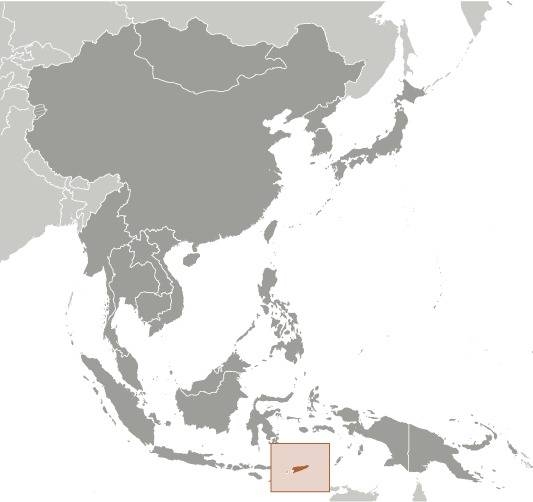Country Summary




Introduction
Background
Timor was actively involved in Southeast Asian trading networks for centuries and by the 14th century exported aromatic sandalwood, slaves, honey, and wax. By mid-16th century, the Portuguese had colonized the island. It was incorporated into Indonesia in July 1976 as the province of Timor Timur (East Timor). On 20 May 2002, Timor-Leste was internationally recognized as an independent state.
Geography
Area
total: 14,874 sq km
land: 14,874 sq km
water: 0 sq km
Climate
tropical; hot, humid; distinct rainy and dry seasons
Natural resources
gold, petroleum, natural gas, manganese, marble
People and Society
Population
1,445,006 (2022 est.)
Ethnic groups
Austronesian (Malayo-Polynesian) (includes Tetun, Mambai, Tokodede, Galoli, Kemak, Baikeno), Melanesian-Papuan (includes Bunak, Fataluku, Bakasai), small Chinese minority
Languages
Tetun Prasa 30.6%, Mambai 16.6%, Makasai 10.5%, Tetun Terik 6.1%, Baikenu 5.9%, Kemak 5.8%, Bunak 5.5%, Tokodede 4%, Fataluku 3.5%, Waima'a 1.8%, Galoli 1.4%, Naueti 1.4%, Idate 1.2%, Midiki 1.2%, other 4.5% (2015 est.)
Religions
Roman Catholic 97.6%, Protestant/Evangelical 2%, Muslim 0.2%, other 0.2% (2015 est.)
Population growth rate
2.15% (2022 est.)
Government
Government type
semi-presidential republic
Capital
name: Dili
Executive branch
chief of state: President José RAMOS-HORTA (since May 2022); note - the president is commander in chief of the military and is able to veto legislation, dissolve parliament, and call national elections
head of government: Prime Minister Taur Matan RUAK (since 22 June 2018)
Legislative branch
description: unicameral National Parliament (65 seats; members directly elected in a single nationwide constituency by closed, party-list proportional representation vote using the D'Hondt method to serve 5-year terms)
Economy
Economic overview
lower middle-income Southeast Asian economy; government expenditures funded via oil fund drawdowns; endemic corruption undermines growth; foreign aid-dependent; wide-scale poverty, unemployment, and illiteracy
Real GDP (purchasing power parity)
$4.19 billion (2020 est.)
Real GDP per capita
$3,200 (2020 est.)
Agricultural products
rice, maize, vegetables, coffee, roots/tubers nes, other meats, cassava, pork, beans, mangoes/guavas
Industries
printing, soap manufacturing, handicrafts, woven cloth
Exports
$60 million (2020 est.)
Exports - partners
Singapore 51%, China 20%, Japan 9%, Indonesia 6% (2019)
Exports - commodities
crude petroleum, natural gas, coffee, various vegetables, scrap iron (2019)
Imports
$850 million (2020 est.)
Imports - partners
Indonesia 39%, China 27%, Singapore 10%, Malaysia 5% (2019)
Imports - commodities
refined petroleum, cars, cement, delivery trucks, motorcycles (2019)
Page last updated: Sunday, August 28, 2022